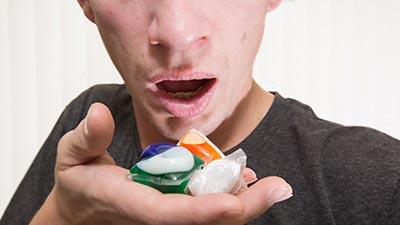- It started as a spoof and then went viral in one of the most baffling social media trends of 2017: teens posting memes and videos of themselves pretending to gorge on laundry detergent pods by stuffing them in their mouths and chewing them up. Tide Pods have been a concern for consumer protection groups since their release in 2012, and for good reason: most of the reported cases of ingestion have involved young kids or older adults with dementia mistaking the colorful plastic-coated packets for something edible.
YouTube has said it will remove videos featuring the Tide pod challenge, and Tide has issued a statement saying that the highly concentrated pods are for cleaning laundry, not for playing with — even in jest. According to the American Association of Poison Control Centers, ingesting the concentrated detergent can cause chemical burns, coma, seizure, pulmonary edema, and respiratory arrest. That’s no joke. -
The cinnamon challenge

Now leading in the category of “things you wish you could un-see” are more than a million YouTube videos of teens swallowing heaping spoonfuls of ground cinnamon. Cue streaming tears, powdery gasps, laughing friends.
While cinnamon is edible, swallowing it dry in these quantities has resulted in kids suffering respiratory distress, burns, and vomiting. Some teens have suffered collapsed lungs and ended up on ventilators from ingesting cinnamon in these quantities, according to an NIH journal article in the American Academy of Pediatrics journal Pediatrics. In this case, spice is not nice.
-
Dripping and Juuling

While cigarette smoking among teens has been declining since the 1990s, vaping, or using e-cigarettes, is on the rise. And there’s a hack that makes it potentially more harmful. A recent study found that a quarter of teenaged e-cigarette users have tried “dripping”: pouring liquid nicotine onto the exposed heating coils of the e-cigarette to produce a thicker cloud of vapor and potentially releasing a higher level of toxins, including formaldehyde.
And then there’s a new type of e-cigarette (the most popular brand is Juul) that heats up a cartridge containing nicotine, creating a nearly invisible vapor. The small, sleek devices are easy to conceal and the cartridges comes in sweet, fruity flavors. They’ve become wildly popular among middle and high school students, prompting the FDA to propose a plan to keep these flavored tobacco products out of the hands of minors. The danger? Nicotine is highly addictive and the cartridges contain a much higher concentration of nicotine than a cigarette.
-
Edibles

Edibles — treats containing marijuana — are widely available in states where recreational marijuana is sold, and their consumption by teenagers is on the rise, according to a recent survey by the National Institute on Drug Abuse. They’re likely to contain a bigger serving of tetrahydrocannabinol (THC) than the pot brownies you remember. Eating weed-laced cookies, brownies, and gummy bears might seem more benign than burning down, but because it takes longer to feel the effects when you ingest the drug, teens might be tempted to keep eating when they don’t feel something right away, leading to a toxic overdose. Make sure your teen knows that edibles can be either homemade or, in states where they’re legal, made by a commercial bakery.
-
Sleeping with a smartphone

While not as obviously hazardous as, say, chomping on laundry detergent packets, sleeping with a phone within arm’s reach is a ubiquitous practice that has potentially harmful consequences for teens. A 2017 study published in the journal Child Development found that using smartphones late at night, specifically for social media, is directly linked to depression, poor coping skills, and reduced self-esteem in teens. In light of recent evidence that the time teens spend on their phones has negative effects on their well-being (including a survey that found one in five teens say they regularly wake up in the middle of the night to check social media), giving kids and teens a digital curfew — a designated time each night when all devices are placed out of reach — just makes sense.
-
Online porn

Access is as easy as picking up your phone: today’s teens are exposed to online porn at earlier ages and in greater numbers than previous generations. Boston University School of Public Health professor Emily Rothman’s research on 16- and 17-year-olds was the subject of a New York Times feature, which reported that twice as many teens had watched porn as their parents thought. Most of the kids in Rothman’s study said watching porn was how they learned about sex. Dr. Wes Crenshaw, a Kansas City-based clinical psychologist who specializes in adolescent development and who is writing a book about sex ed that’s based on mutual consent, says that teens looking at porn are “high-interest learners.” The problem, he says, is that pornography tends to portray sex in a way that’s “masculocentric, degrading to women, and wildly inaccurate and unrealistic.” The result can be teens with skewed ideas about sex, intimacy, consent, reciprocity, gender roles, and power. “These images,” Crenshaw says, “distort for [teens] what sex should be about.”
The best way for parents to help? Talk to your teen and encourage them to think critically about what they see and how that relates (or doesn’t relate) to reality.
The Tide pod challenge













